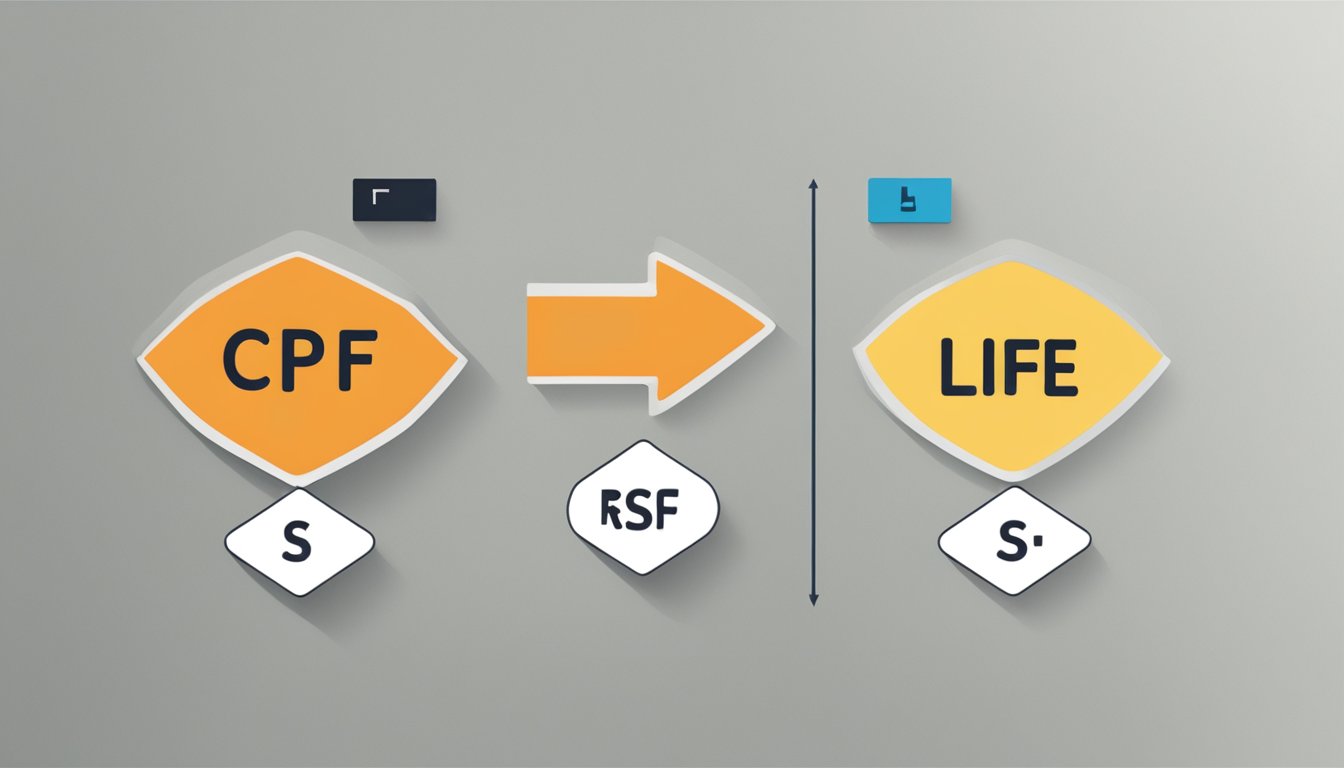CPF Life vs RSS Singapore: Which is the Better Choice for Your Retirement?

Planning for retirement is a crucial aspect of personal finance, and Singaporeans have the advantage of the Central Provident Fund (CPF) to help them achieve their retirement goals. CPF offers two retirement schemes, the Retirement Sum Scheme (RSS) and CPF LIFE, which replaced RSS as the default CPF payout scheme for Singaporeans in retirement. CPF LIFE provides monthly payouts for life, while RSS provides monthly payouts until the sum runs out.
Understanding CPF and Its Role in Retirement
CPF is a mandatory savings scheme that helps Singaporeans save for their retirement, healthcare, and housing needs. CPF contributions are made by both the employee and the employer and are based on a percentage of the employee’s wage. The CPF funds are then invested in various instruments, including bonds and stocks, to generate returns. CPF members can use their CPF savings to purchase a home, pay for healthcare expenses, and receive payouts during their retirement.
Key Takeaways
- CPF offers two retirement schemes, the Retirement Sum Scheme (RSS) and CPF LIFE, which replaced RSS as the default CPF payout scheme for Singaporeans in retirement.
- CPF LIFE provides monthly payouts for life, while RSS provides monthly payouts until the sum runs out.
- Maximising your CPF savings is crucial to achieving your retirement goals.
Understanding CPF and Its Role in Retirement

If you’re a Singaporean, you’re likely familiar with the Central Provident Fund (CPF) and its role in your retirement. CPF is a mandatory social security savings scheme for Singaporeans and Permanent Residents (PRs) that helps them save for their retirement, healthcare, and home ownership.
The Basics of CPF
CPF contributions come from both employees and employers, and they are divided into three accounts: the Ordinary Account (OA), the Special Account (SA), and the MediSave Account (MA). The OA is for housing, education, and investment, while the SA is for retirement and investment. The MA is for healthcare expenses such as hospitalization and outpatient treatment.
CPF contributions earn interest rates, which are reviewed quarterly and adjusted based on market conditions. In 2021, the interest rate for the OA is 2.5%, the SA is 4.0%, and the MA is 3.0%.
CPF’s Retirement Sum Scheme (RSS)
CPF’s Retirement Sum Scheme (RSS) is the main retirement payout plan for those born before 1958. Under the RSS, members are required to set aside a retirement sum in their Retirement Account (RA) when they turn 55. The retirement sum is determined based on the member’s age and the prevailing Minimum Sum. In 2021, the Minimum Sum is $186,000.
When members reach the payout eligibility age of 65, they can choose to receive monthly payouts from their RA for as long as they live. The amount of the monthly payout is determined by the retirement sum they have set aside, the interest earned on their CPF savings, and the payout duration they choose.
CPF LIFE replaced the old Retirement Sum Scheme (RSS) as the default CPF payout scheme for Singaporeans in retirement. CPF LIFE provides monthly payouts for life and offers members the choice of different plans based on their preferences. Most younger Singaporeans and PRs will automatically find themselves on the CPF LIFE scheme when they turn 55.
In conclusion, understanding CPF and its role in retirement is crucial for all Singaporeans and PRs. CPF’s Retirement Sum Scheme (RSS) is the main retirement payout plan for those born before 1958, while CPF LIFE is the default CPF payout scheme for younger Singaporeans and PRs. By making regular CPF contributions and planning ahead, you can build a solid foundation for your retirement and enjoy a comfortable retirement lifestyle.
Diving Into CPF LIFE

If you’re approaching retirement age in Singapore, you may be wondering about the difference between CPF LIFE and the Retirement Sum Scheme (RSS). CPF LIFE is the default scheme for Singaporeans and Permanent Residents born in 1958 or after. Here’s what you need to know about CPF LIFE.
CPF LIFE Plans Overview
CPF LIFE offers two plans: the Standard Plan and the Basic Plan. The Standard Plan offers higher monthly payouts but requires a higher premium, while the Basic Plan offers lower monthly payouts with a lower premium. You can choose which plan you want to enroll in based on your financial needs.
Under the Standard Plan, you can choose between receiving monthly payouts for life or for a fixed period of 10, 15, or 20 years. The Basic Plan only offers monthly payouts for life.
CPF LIFE Estimator and Premiums
To help you decide which plan to enroll in, you can use the CPF LIFE Estimator. This tool will give you an estimate of your monthly payouts based on your premium amount and the plan you choose.
Your CPF LIFE premium is deducted from your Retirement Account (RA) savings when you join CPF LIFE. The premium amount depends on your age, the plan you choose, and the amount of money you have in your RA.
For example, if you’re 55 years old and choose the Standard Plan, your premium would be around $60,000. If you’re 65 years old and choose the Basic Plan, your premium would be around $20,000.
Overall, CPF LIFE is a great option for those looking for a reliable source of income during retirement. With two plans to choose from and a CPF LIFE Estimator to help you make an informed decision, you can find the plan that best suits your needs.
Comparing CPF LIFE and RSS

If you’re planning for retirement in Singapore, you may have heard of CPF LIFE and RSS. Both of these schemes provide monthly payouts to eligible Singaporeans, but they have some key differences.
Key Differences Between CPF LIFE and RSS
One of the main differences between CPF LIFE and RSS is that CPF LIFE provides lifelong monthly payouts, while RSS payouts stop at age 90 or when your savings run out, whichever comes first. This means that CPF LIFE provides more security and peace of mind for those who are worried about outliving their savings.
Another difference is that CPF LIFE premiums are deducted from your Retirement Account savings when you join the scheme, while RSS payouts are based on the amount of money you have saved in your Retirement Account. This means that CPF LIFE may be a better option for those who have more savings in their Retirement Account.
Eligibility and Payout Comparisons
To be eligible for CPF LIFE, you must be a Singaporean or Permanent Resident and have at least $60,000 in your Retirement Account when you reach the payout eligibility age of 65. On the other hand, the Retirement Sum Scheme is the main retirement payout plan for those born before 1958.
When it comes to monthly payouts, CPF LIFE payouts are adjusted annually based on the performance of the CPF Investment Scheme, while RSS payouts are fixed and do not change. CPF LIFE payouts also provide a higher monthly payout amount compared to RSS payouts.
Overall, both CPF LIFE and RSS have their pros and cons, and the best option for you will depend on your individual circumstances and preferences. It’s important to do your research and speak to a financial advisor to determine which scheme is right for you.
Maximising Your Retirement Funds

Retirement planning is essential to ensure that you have enough funds to maintain your lifestyle when you retire. The CPF Life and Retirement Sum Scheme (RSS) are two popular options for Singaporeans to consider. In this section, we will discuss how you can maximise your retirement funds using these schemes.
Enhancing CPF Savings
One way to maximise your CPF savings is to defer the payout age of your CPF Life or RSS. The longer you defer, the higher your monthly payouts will be. You can also choose to top up your CPF accounts to reach the Full Retirement Sum (FRS), which is currently $186,000. By doing so, you will receive higher monthly payouts from CPF Life or RSS.
Another option is to take advantage of the Supplementary Retirement Scheme (SRS). SRS is a voluntary scheme that allows you to save for retirement and enjoy tax benefits. You can contribute up to $15,300 annually to your SRS account and enjoy tax relief on the amount contributed. The funds in your SRS account can be used to purchase investment-linked plans (ILPs) or other investment products.
Additional Retirement Planning Options
Apart from CPF Life and RSS, there are other retirement planning options that you can consider. You can speak to a Wealth Planning Manager to discuss your retirement goals and financial health. They can provide you with a Financial Health Check to assess your current financial situation and recommend suitable retirement planning options.
You can also consider purchasing ILPs or other investment products to diversify your retirement portfolio. However, it is important to note that ILPs come with higher fees and charges compared to other investment products. Hence, you should carefully consider the risks and benefits before making any investment decisions.
In conclusion, maximising your retirement funds requires careful planning and consideration of various options. By deferring your CPF payout age, topping up your CPF accounts, and exploring other retirement planning options, you can ensure that you have enough funds to maintain your lifestyle when you retire.
CPF LIFE and the Broader Financial Landscape

When it comes to planning for your retirement, CPF LIFE is just one of the many options available to you. Here, we’ll take a look at how CPF LIFE fits into the broader financial landscape, and what other retirement solutions you might want to consider.
CPF LIFE in Context
CPF LIFE is designed to provide a basic level of retirement income for Singaporeans. It’s the default CPF payout scheme, which means that if you don’t actively choose another option, you’ll be automatically enrolled in CPF LIFE when you turn 65.
One of the benefits of CPF LIFE is that it provides a guaranteed stream of retirement income for life. This can be especially reassuring for retirees who are worried about outliving their savings. However, it’s important to keep in mind that CPF LIFE payouts may not be enough to cover all of your retirement expenses, especially if you have a higher cost of living or if you have additional retirement funds that you need to draw upon.
Alternative Retirement Solutions
If you’re looking for additional retirement income beyond what CPF LIFE provides, there are a few other options you might want to consider. Here are a few examples:
-
High-interest savings accounts: Some banks offer high-interest savings accounts that can provide a reliable source of retirement income. These accounts typically have higher interest rates than regular savings accounts, which means that your money can grow more quickly over time.
-
Annuities: An annuity is a type of insurance scheme that provides a guaranteed stream of income for life. You typically pay a lump sum upfront, and in return, you receive regular payouts for the rest of your life. Annuities can be a good option if you’re looking for a reliable source of retirement income, but they may not be the best choice if you’re looking for flexibility or if you want to leave money to your beneficiaries.
-
Investment-linked plans (ILPs): ILPs are a type of insurance product that combines life insurance with investment options. You pay a premium, and a portion of that premium goes towards a life insurance policy, while the rest is invested in a range of investment options. ILPs can be a good option if you’re looking for a way to grow your retirement savings, but they can also be risky if you’re not careful.
-
Additional retirement funds: If you’re a freelancer or self-employed, you may want to consider setting up additional retirement funds to supplement your CPF savings. This could include things like T-bills, savings accounts, or other investment options.
Overall, CPF LIFE is a good option for Singaporeans who are looking for a reliable source of retirement income. However, it’s important to keep in mind that there are other retirement solutions available, and you should carefully consider your options before making a decision. By doing your research and planning ahead, you can ensure that you have the financial security you need to enjoy your retirement years.
Frequently Asked Questions

What are the differences in payouts between CPF Life and the Retirement Sum Scheme?
CPF Life and the Retirement Sum Scheme (RSS) are two different schemes that provide retirement income to Singaporeans. The main difference between the two schemes is the way the payouts are calculated. CPF Life is designed to provide a steady stream of income for life, while the RSS provides a fixed sum of money over a period of time.
Can I switch from the Retirement Sum Scheme to CPF Life, and how does it work?
Yes, you can switch from the Retirement Sum Scheme to CPF Life. However, it is important to note that once you switch to CPF Life, you cannot switch back to the RSS. To switch to CPF Life, you will need to have the Full Retirement Sum (FRS) in your Retirement Account (RA), which is currently set at $186,000. You can make the switch by submitting an application to the Central Provident Fund Board (CPFB).
Why might CPF Life be considered a superior option to owning an investment property?
CPF Life is considered a superior option to owning an investment property because it provides a guaranteed stream of income for life, regardless of market conditions. Owning an investment property, on the other hand, comes with risks such as market fluctuations and maintenance costs. CPF Life also provides a higher rate of return compared to many investment properties, making it a more attractive option for retirement income.
Is enrolment in CPF Life compulsory for all Singaporeans?
Enrolment in CPF Life is not compulsory for all Singaporeans. However, most Singaporeans will be automatically enrolled in CPF Life when they reach the age of 65. Those who are born before 1958 and have a Retirement Account (RA) balance of at least $60,000 six months before their Payment Eligibility Age (PEA) can choose between CPF Life and the RSS.
How can I estimate my future payouts using the CPF LIFE calculator?
You can estimate your future payouts using the CPF LIFE calculator, which is available on the Central Provident Fund Board (CPFB) website. To use the calculator, you will need to provide information such as your age, gender, and CPF account balance. The calculator will then generate an estimate of your monthly payouts under CPF Life.
What enhancements have been made to the CPF LIFE payout table in 2023?
In 2023, enhancements were made to the CPF LIFE payout table to provide higher payouts for Singaporeans. The enhancements include an increase in the Basic Retirement Sum (BRS) and the Full Retirement Sum (FRS), as well as an increase in the CPF Life Escalating Plan payout rates. These enhancements are aimed at providing Singaporeans with a more comfortable retirement.




